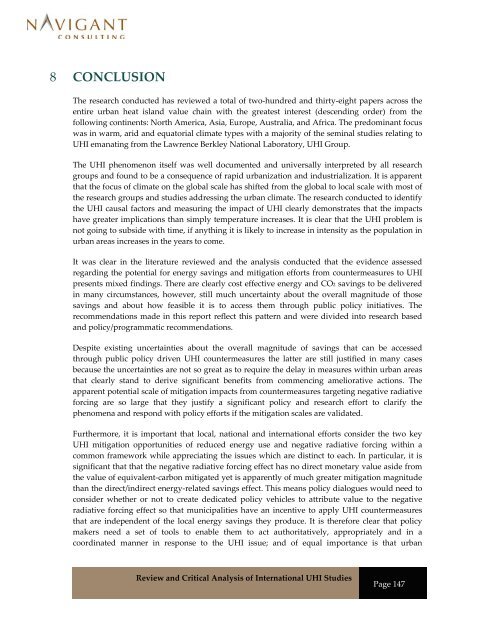Review and Critical Analysis of International UHI Studies
Review and Critical Analysis of International UHI Studies
Review and Critical Analysis of International UHI Studies
Create successful ePaper yourself
Turn your PDF publications into a flip-book with our unique Google optimized e-Paper software.
8 CONCLUSION<br />
The research conducted has reviewed a total <strong>of</strong> two‐hundred <strong>and</strong> thirty‐eight papers across the<br />
entire urban heat isl<strong>and</strong> value chain with the greatest interest (descending order) from the<br />
following continents: North America, Asia, Europe, Australia, <strong>and</strong> Africa. The predominant focus<br />
was in warm, arid <strong>and</strong> equatorial climate types with a majority <strong>of</strong> the seminal studies relating to<br />
<strong>UHI</strong> emanating from the Lawrence Berkley National Laboratory, <strong>UHI</strong> Group.<br />
The <strong>UHI</strong> phenomenon itself was well documented <strong>and</strong> universally interpreted by all research<br />
groups <strong>and</strong> found to be a consequence <strong>of</strong> rapid urbanization <strong>and</strong> industrialization. It is apparent<br />
that the focus <strong>of</strong> climate on the global scale has shifted from the global to local scale with most <strong>of</strong><br />
the research groups <strong>and</strong> studies addressing the urban climate. The research conducted to identify<br />
the <strong>UHI</strong> causal factors <strong>and</strong> measuring the impact <strong>of</strong> <strong>UHI</strong> clearly demonstrates that the impacts<br />
have greater implications than simply temperature increases. It is clear that the <strong>UHI</strong> problem is<br />
not going to subside with time, if anything it is likely to increase in intensity as the population in<br />
urban areas increases in the years to come.<br />
It was clear in the literature reviewed <strong>and</strong> the analysis conducted that the evidence assessed<br />
regarding the potential for energy savings <strong>and</strong> mitigation efforts from countermeasures to <strong>UHI</strong><br />
presents mixed findings. There are clearly cost effective energy <strong>and</strong> CO2 savings to be delivered<br />
in many circumstances, however, still much uncertainty about the overall magnitude <strong>of</strong> those<br />
savings <strong>and</strong> about how feasible it is to access them through public policy initiatives. The<br />
recommendations made in this report reflect this pattern <strong>and</strong> were divided into research based<br />
<strong>and</strong> policy/programmatic recommendations.<br />
Despite existing uncertainties about the overall magnitude <strong>of</strong> savings that can be accessed<br />
through public policy driven <strong>UHI</strong> countermeasures the latter are still justified in many cases<br />
because the uncertainties are not so great as to require the delay in measures within urban areas<br />
that clearly st<strong>and</strong> to derive significant benefits from commencing ameliorative actions. The<br />
apparent potential scale <strong>of</strong> mitigation impacts from countermeasures targeting negative radiative<br />
forcing are so large that they justify a significant policy <strong>and</strong> research effort to clarify the<br />
phenomena <strong>and</strong> respond with policy efforts if the mitigation scales are validated.<br />
Furthermore, it is important that local, national <strong>and</strong> international efforts consider the two key<br />
<strong>UHI</strong> mitigation opportunities <strong>of</strong> reduced energy use <strong>and</strong> negative radiative forcing within a<br />
common framework while appreciating the issues which are distinct to each. In particular, it is<br />
significant that that the negative radiative forcing effect has no direct monetary value aside from<br />
the value <strong>of</strong> equivalent‐carbon mitigated yet is apparently <strong>of</strong> much greater mitigation magnitude<br />
than the direct/indirect energy‐related savings effect. This means policy dialogues would need to<br />
consider whether or not to create dedicated policy vehicles to attribute value to the negative<br />
radiative forcing effect so that municipalities have an incentive to apply <strong>UHI</strong> countermeasures<br />
that are independent <strong>of</strong> the local energy savings they produce. It is therefore clear that policy<br />
makers need a set <strong>of</strong> tools to enable them to act authoritatively, appropriately <strong>and</strong> in a<br />
coordinated manner in response to the <strong>UHI</strong> issue; <strong>and</strong> <strong>of</strong> equal importance is that urban<br />
<strong>Review</strong> <strong>and</strong> <strong>Critical</strong> <strong>Analysis</strong> <strong>of</strong> <strong>International</strong> <strong>UHI</strong> <strong>Studies</strong><br />
Page 147


